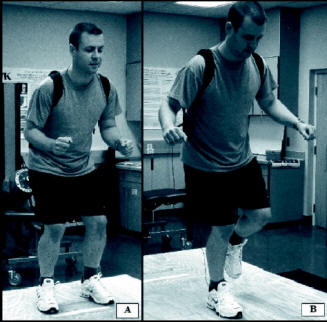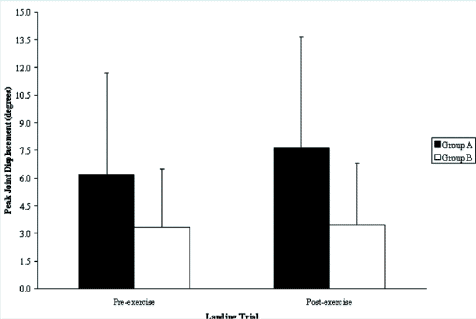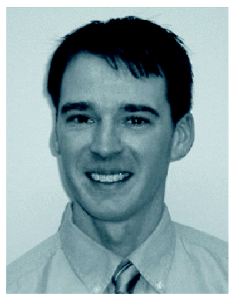| |
 |
|
|
|
 |
| • |
Join the
FUN at
the 2006
NATA
Annual
Meeting
… |
|
 |
| • |
Funding
for
Three
General
& Four
Master's
Grants Approved |
|
 |
 |
| • |
Evidence-Based
Medicine
Summit a
Success |
|
 |
| • |
District II Membership wins 2005 Annual Fund Contest, 2006 Goals Set |
|
 |
 |
| • |
Investor
Report
for 2005 |
|
 |
| • |
NATA REF Web Pages for each District |
|
 |
 |
| • |
GRANT INFORMATION SUMMARY
Relationship Between Hip Abductor Strength and Endurance With Functional Performance |
|
 |
| • |
NATA Research & Education Foundation Grant Deadlines, Education Programs & Planned Giving |
|
 |
|
|
|
Join the
FUN at
the 2006
NATA
Annual
Meeting
…
...
support
the NATA
Research
&
Education
Foundation |
|
|
NATA Foundation
Golf Classic
at
Stone Mountain Golf Club
Wednesday, June 14, 2006
7:00 AM or 12:30 PM
tee times |
NATA Foundation Run
at
Piedmont Park, Atlanta
Friday, June 16, 2006
7:00 AM start time |
NATA Foundation Night
with the
Atlanta Braves &
Boston Red Sox
at Turner Field
on
Friday, June 16, 2006
7:35 PM First Pitch |
You
won't
want to
miss the
fun at
these
Foundation
activities
during
the NATA
Annual
Meeting
&
Clinical
Symposia
in
Atlanta.
The NATA
Foundation
Golf
Classic,
NATA
Foundation
Night
and NATA
Foundation
Fun
Run/Walk
…
there's
something
for
everyone!
Your
participation
will
help the
NATA
Research
&
Education
Foundation
continue
to offer
a wide
variety
of
programs
and
activities
to help
Athletic
Trainers
do their
jobs
more
effectively
every
day!
Click
here
for more
information!
Download
Registration
Form
Register
Online
|
|
|
|
|
|
Evidence-Based Medicine Summit a Success |
|
|
|
Foundation
President
Mike
Sitler
reports
that the
“Infusing
Evidence-Based
Medicine
into
Athletic
Training
Research
and
Clinical
Practice”
Summit
held
January
13, 2006
in
Atlanta,
GA was a
success.
Instrumental
to
success
of the
summit
was the
joint
financial
support
provided
by the
NATA and
Foundation
Boards
of
Directors
which
allowed
costs
for
participants
to be
held to
a
minimum.
A total
of 62
individuals
participated
in the
summit.
Based on
solicited
and
unsolicited
oral and
written
feedback,
the
summit
was of
high
quality
and
useful
to those
in
attendance.
One
attendee
commented
that .
. . “the
lecturers
had
interesting
and
informative
presentations,
were
knowledgeable
in their
subject
matter,
and
effectively
interacted
with
attendees,”
which
summarizes
the
sentiments
expressed
by many
in
attendance.
Based on
feedback
from
participants,
there
appears
to be
interest
in
holding
future
summits,
workshops,
etc. on
EBM. No
decision
has been
made in
this
regard,
but the
prospect
of
holding
future
EBM
educational
opportunities
will be
considered
at the
appropriate
time.
As this
is an
important,
emerging
area in
the
health
professions,
providing
additional
educational
opportunities
on EBM
would
serve to
further
facilitate
its
infusion
into
athletic
training
educational
settings
and
clinical
practice.
Thank you again for providing financial support to advance
EBM into
the
athletic
training
profession.
Please
take a
moment
to
complete
this
brief
survey
on
Evidence-Based
Medicine.
http://at.uwa.edu/nataref/ebmsurvey.htm |
|
|
|
|
|
|
|
Research
Programs
-
Over
$700,000
in
grants
awarded
in
past
three
years
-
Approximately
200
Free
Communications
Presentations/Posters
were
presented
at
the
NATA
Annual
Meeting
in
Indianapolis
-
Foundation
grant
recipients
presented
their
findings
to
the
NATA
membership
-
Abstracts
of
original
research
were
published
in
the
summer
supplement
to
the
Journal
of
Athletic
Training
-
30,000
NATA
members
received
an
original
research
supplement
to
the
Journal
of
Athletic
Training
-
Grant
Information
Summaries,
published
from
funded
research
projects,
were
made
available
to
NATA
members
through
the
Foundation
website
and
at
National
and
District
Meetings
-
The
Medal
for
Distinguished
Athletic
Training
Research
presented
in
honor
of
Joseph
S.
Torg,
MD
-
The
New
Investigator
Award
presented
in
honor
of
Freddie
H.
Fu,
MD
-
Doctoral
Dissertation
Award
presented
in
honor
of
David
H.
Perrin,
PhD,
ATC
Education
Programs
-
$136,000
awarded
through
Foundation
Scholarship
Program
-
Distribution
of
free
palm
cards
on
Sudden
Death
in
Athletes
-
Funding
for
development
of
Home
Study
courses
-
Funding
for
Athletic
Training
Educators’
Conference
-
Distribution
of
Sudden
Death
Summit
position
paper
-
Presentation
of
Lecture
Exchange
Program
with
the
AMSSM,
AOSSM
and
ACSM
-
Educational
research/program
grants
|
|
|
|
|
|
GRANT INFORMATION SUMMARY
Relationship Between Hip Abductor Strength and Endurance With Functional Performance |
|
|
|
PRACTICAL
SIGNIFICANCE
When
landing
from a
jump,
individuals
with
weak hip
abductors
allow
their
hip to
adduct
and knee
to move
into
more
valgus,
which
places
the knee
in a
potentially
vulnerable
position
for
injury.
STUDY
BACKGROUND
Weakness
of the
hip
abductors
has been
associated
with
chronic
knee
injuries
such as
patellofemoral
pain
syndrome
(PFP).
The
proposed
mechanism
for PFP
is
increased
hip
adduction
and
internal
rotation,
which is
thought
to
increase
knee
valgus
and
tibial
external
rotation.
The
combination
of these
rotations
has also
been
described
as a
common
mechanism
of
non-contact
ACL
injury,
specifically
when
landing
from a
jump.
During
this
activity,
the hip
abductors
help
maintain
neutral
pelvic
and
lower
extremity
alignment,
which
may
reduce
the risk
of
injury.
It is
unclear
as to
what
role hip
endurance,
strength,
and
landing
leg
preference
has on
knee and
hip
alignment
during
landing.
OBJECTIVE
To
compare
hip and
knee
joint
kinematics
when
landing
from a
jump in
physically
active
individuals
that
have
differing
levels
of hip
abduction
strength
and
endurance.
DESIGN
AND
SETTING
This
clinical
laboratory
based
protocol
used two
mixed
model 2
x 2
repeated
measures
design.
The
independent
variables
were
strength
(strong,
weak)
and
fatigue
state
(pre-fatigue,
post-fatigue)
for the
first
analysis.
The
independent
variables
were
endurance
(high,
low) and
fatigue
state (prefatigue,
post-fatigue)
for the
second
analysis.
The
dependent
variables
analyzed
in both
analyses
were hip
and knee
3-D
kinematics.
SUBJECTS
Thirty
healthy
subjects
(15
women,
15 men;
age=23.8±2.9
yrs).
MEASUREMENTS
Subjects
completed
3
pre-exercise
trials (Lpre)
of a
double-leg
hop with
a
single-leg
landing.
(Figure
1)
The
length
and
height
of the
hop were
controlled
as a
percentage
of each
subject’s
height.
Mean
peak
joint
displacement
values
for the
hip and
knee
were
collected
during
the
trials.
Hip
abductor
strength
was then
determined
as the
subjects
performed
3
maximal
voluntary
isometric
contractions
(MVIC).
Subjects
then
maintained
50% of
their
MVIC to
the
limits
of their
endurance.
Following
20
minutes
of rest,
subjects
completed
a 30
second
bout of
isometric
hip
abduction,
again
with 50%
MVIC.
From
this, we
determined
the
percent
of
maximal
endurance
utilized.
Immediately
following
the bout
of
exercise,
subjects
completed
3
post-exercise
landing
trials (Lpost).
For
statistical
analysis,
subjects
were
stratified
into
groups
based on
their
hip
abductor
strength
and
endurance.
RESULTS
Subjects
with
strength
values
above
the
median
landed
with
less hip
adduction
and knee
valgus
than the
weaker
subjects.
(Figure
2) There
were no
differences
in knee
and hip
motion
when the
subjects
were
stratified
by
endurance.
There
was a
low, but
significant
inverse
relationship
between
hip
abductor
strength
and knee
valgus
displacement
during
both the
Lpre (r
= -0.30)
and
Lpost
trials
(r =
-0.39, P
< 0.05).
CONCLUSIONS
The hip
abductors
contribute
to
neuromuscular
control
of the
knee
when
landing
from a
jump.
Strength
of the
hip
abductors
may play
a more
vital
role in
controlling
knee
motion
than the
endurance
capacity
of this
muscle
group.
|

Figure 1. Subject performing the functional task of a double leg hop (A) with a single leg landing (B). |
|

Figure 2. Differences in knee valgus peak joint displacement between groups of subjects stratified by peak torque of the hip abductors. Group A demonstrated peak torque values below the median level, Group B demonstrated values above the median level.
* denotes significant greater knee valgus in Group A over Group B (P < 0.05) |
Publication
and
Presentation
List:
-
Jacobs
C,
Mattacola
CG,
Uhl
TL,
Shapiro
R,
Rayens
WS.
The
influence
of
hip
abductor
strength,
endurance,
and
asymmetry
on
lower
extremity
landing
kinematics.
Southeast
Athletic
Trainers’
Association
Clinical
Symposium,
Atlanta,
GA,
2005.
-
Jacobs
C,
Mattacola
CG,
Uhl
TL,
Shapiro
R,
Rayens
WS.
Relationship
of
hip
abductor
strength
and
endurance
with
the
kinematics
of
landing.
Journal
of
Athletic
Training.
2005
(suppl);40:S65.
|

Cale Jacobs, PhD, ATC
Principal Investigator
|
Cale Jacobs has just completed his Doctorate in Exercise Sciences from the University of Kentucky in May of 2005. He is presently employed at the Lexington Clinic as a Clinical Researcher.
Cale Jacobs, PhD, ATC
Lexington Clinic
Research Assistant-Orthopaedics
700 Bob-O-Link Drive
Lexington, KY 40504
(859) 258-8560
cjaco@lexclin.com |
|
This Grant Information Summary may be downloaded in a 2-page pdf file from http://www.natafoundation.org/pdfs/Jacobs,Cale.pdf. |
|
|
|
|
|
|
Funding
for
Three
General
& Four
Master's
Grants Approved |
|
|
|
On
the
December
14, 2005
Board of
Directors
Conference
Call, the
Foundation
Board
approved
a total
of
$171,727.00 funding
for the
following
grants:
General
Grants
-
R.
Dawn
Comstock,
PhD
Columbus
Children’s
Research
Institute
“On-Line
Surveillance
of
High
School
Sports
Injuries”
$84,811
-
Peter
Giacobbi,
PhD
University
of
Florida
“Occupational
Stress,
Coping
and
Burnout
Detection
in
the
Athletic
Training
Profession”
$54,779
-
John
A.
Mercer,
PhD
University
of
Nevada,
Las
Vegas
“Shock
Attenuation
Characteristics
for
Children
Runners”
$28,517
Osternig
Master's
Research
Grants
-
Nicole
L.
Craig,
BA
University
of
Northern
Iowa
“Validation
of
Accelerometers
as a
Measure
of
Knee
Dysfunction
and
Recovery”
$1,000
-
Lyndsay
Smith,
BS,
ATC
Georgia
Southern
University
“Effect
of
Attention
Focus
Interventions
in
Anterior
Tibial
Shear
Forces
During
Landing
in
Females”
$1,000
-
Eric
J.
Simmons,
ATC
Arizona
School
of
Health
Sciences
“Conservative
Vs.
Operative
Intervention
for
Atraumatic
Glenohumeral
Instability
in
The
Overhead
Athlete:
A
Systematic
Review”
$620
-
Eric
A.
Sorenson,
BA,
ATC
University
of
Oregon
“Prostaglandin
E2
Production
Associated
with
Exercise-Induced
Muscle
Damage”
$1,000
|
|
| |
|
|
District II Membership wins 2005 Annual Fund Contest, 2006 Goals Set |
|
|
|
Congratulations to the District II membership under the
leadership
of
District
II Chair
Steve
Bair for
winning
the
Annual
Fund
Contest
for
2005.
The
district
that
reaches
the
highest
percentage
of its
goal
based
upon its
number
of
members
wins the
competition.
In 2005
District
II
reached
199.98%
of its
$16,040
goal by
raising
$32,077
through
district,
state
and
member
contributions.
In
addition
to
District
II, six
other NATA
Districts
reached
over
100% of
their
goals
for
2005.
2005
Annual
Fund
Contest
Results
and
2006
Goals
|
District |
2005 Goal |
Amount raised |
% of Goal |
2006 Goal |
|
1 |
$7,428 |
$13,672 |
184.06 |
$ 8,400 |
|
2 |
$16,040 |
$32,077 |
199.98 |
$18,100 |
|
3 |
$12,192 |
$13,942 |
114.35 |
$13,800 |
|
4 |
$23,957 |
$15,463 |
64.54 |
$27,100 |
|
5 |
$9,424 |
$6,028 |
63.96 |
$10,600 |
|
6 |
$6,785 |
$10,297 |
151.76 |
$ 7,700 |
|
7 |
$5,822 |
$4,244 |
72.90 |
$ 6,600 |
|
8 |
$9,148 |
$14,739 |
161.12 |
$10,300 |
|
9 |
$15,775 |
$26,725 |
169.41 |
$17,800 |
|
10 |
$4,914 |
$7,556 |
153.76 |
$ 5,500 |
|
International |
$1,015 |
$923 |
90.94 |
$ 1,100 |
|
Total |
$112,500 |
$145,666 |
129.48 |
$127,000 |
|
|
|
|
|
|
NATA
REF Web
Pages
for each
District |
|
|
|
NATA
Research
&
Education
Foundation
web
pages
have
been
created
for each
of the
ten NATA
districts
to
provide
detailed
information
regarding
individual
district
and
state
representative
contact
information,
listings
of
district
grant,
scholarship
and
award
recipients
as well
as links
to
numerous
reports,
presentations,
donation
forms,
grants,
and
scholarship
information.
Click
below on
the
appropriate
link to
learn
more
about
your
district's
involvement
with the
Foundation.
|
|
| |
|
|
NATA Research & Education Foundation Grant Deadlines, Education Programs & Planned Giving |
|
|
|
NATA Research & Education Foundation
Grant Deadlines
Education
Programs
Planned
Giving
Is An
Option
With The
NATA
Foundation
NATA
Research
&
Education
Foundation
2952
Stemmons
Dallas,
TX 75247
214.637.6282
www.natafoundation.org
| |
Supporting
and
advancing
the
athletic
training
profession
through
research
and
education. |
|
|
|
|
|
|
|